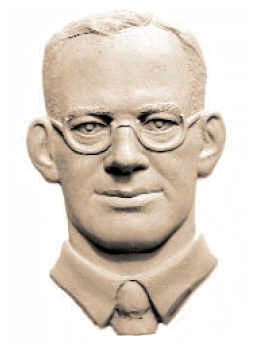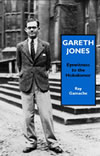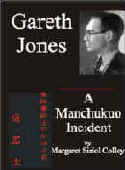Gareth Jones
[bas relief by Oleh Lesiuk]
HOME |
Stop Press |
Complete Soviet Articles & Background Information |
Précis of Gareth's
|
All Published Articles |
BOOKS
|
|
|
|
More Than Grain of Truth(2005) |
|
|
TOPICAL
'Are you Listening NYT?' U.N. Speech - Nov 2009 |
Gareth Recognised at Cambridge - Nov 2009 |
Reporter and the Genocide - Rome, March 2009 |
Order of Freedom Award -Nov 2008 |
Premiere of 'The Living' Documentary Kyiv - Nov 2008 |
Gareth Jones 'Famine' Diaries - Chicago 2008 |
Aberystwyth Memorial Plaque 2006 |
GENERAL
Scholarship Fund |
Site Map |
Links |
Legal Notices |
Sponsored Links |
Contact |
The Enigma of Ireland (i).The Western
Mail - November 6th, 1933
The
Enigma of Ireland
Ulster a Centre of Uneasiness and Strife.Dangers Behind Religious Antagonism.By Gareth Jones“Mark my words,
Ireland is heading full-speed towards the blood and terror of a civil war,”
rapped out the white-haired old gentleman as we sipped our coffee in a London
club. I felt a keen
desire to take the first train to Dublin, but thought twice of it and telephoned
an Irish friend. “Civil war!
Nonsense!” came his voice across the wires. “De Valera has the
whole country at his command and is building up a stronger, finer Ireland, and
winning the economic battle against England.” I was intrigued
and, deciding to seek another view, walked into the office of an expert on the
Irish Free State, who declared: “De Valera, that half-Mexican dictator, is
sending the country to wrack and ruin. Ireland is doomed.
O’Duffy’s Blue Shirts are the only ones who can rescue the country.” CONFLICTING VIEWS
What a medley of
clashing views! The more I asked the more I was puzzled by the varying
analyses of those, on one hand, who described a sinister Irish Republican Army,
drilling in secret with smuggled rifles and machine-guns, and of those on the
other - especially Welsh Nationalist friends of mine - whose picture of Ireland
was a land blossoming under de Valera into a paradise of prosperous peasant
proprietors; of those who bade me hasten there lest I should be too late to see
de Valera declare a republic; and of those who said a republic was never to
come. These conflicting
opinions made my urge to go to that land of dissension almost irrepressible, and
thus I found myself on the Belfast boat watching the lights of Liverpool twinkle
good-night, and wondering whether I should ever glean the slightest information
about that most fascinating and yet most tragic of enigmas - the enigma of
Ireland. BITTERNESS AND ANTAGONISM
Through the night
I lay awake listening to the thud of the engines as the boat made its eight-hour
voyage past the Isle of Man to the capital of Ulster. When it was light I
peeped through the portholes and saw Belfast’s dull wharves and warehouses
looking sulky in the grey morning mist. I wonder how many
rifles passed through those warehouses for Carson’s men before the war, was
the thought that flashed through my mind and I recollected Ulster’s ugly
history of hatred and strife which was not yet at an end, and the root of which
I was destined within a few hours to feel and to see. As soon as I had
left the boat and had found myself in a comfortable home on the outskirts of the
city I seemed to sense an atmosphere of bitterness and antagonism. CATHOLICS AND PROTESTANTS
Whether I am
supersensitive to popular feeling in a strange land I do not know, but just as
hot air weighs down upon one so a certain oppressive tenseness hovered over me
in Belfast. Suddenly I
noticed what it was when I said to my hostess, a charming, jolly woman: “The
relations between the Catholics and the Protestants must be one of the
interesting -----.” Here Mrs. M.
broke in abruptly and chatted about something wholly irrelevant until the
servant-boy had left the room and had shut the door behind him. She put
her hand to her lips to indicate the need for silence, and said: “We never
talk about religion in front of the servants. The hatred between the
Protestants and the Catholics is the curse of Ulster, and unless carefully
handled poisons all human relationships. So be careful what you say when
others are about.” THE COOK AND THE MAID
It is really as
bad as that? I asked. My hostess replied by telling me of an English
family who had come to live in Ulster and laughed at the tradition that Catholic
and Protestant servants could not be mixed. They engaged a Catholic cook
-fat and forty - and a little wisp of a Protestant kitchen-maid. The experiment
was a great success, and the atmosphere in the kitchen was as amicable as it
could be, until the family went away for, a holiday, leaving the pair behind.
One day the English people received a telegram: “Come back immediately.
House wrecked.” They took the first train home, entered the house, and
found shattered furniture, broken pictures, and a litter of smashed crockery.
After a bout of questioning, they got at the cause of the destruction. The
Catholic cook and the Protestant maid had been seated happily before the fire
when the cook said: “I wonder what William of Orange is now doing in hell?” “Having a chat
with the Pope, probably,” replied the Orange girl - and the furies of
centuries of religious strife entered their souls, gave power to their arms, and
they did not rest until they lay weary amid the wreckage their fight had caused. REASON FOR PAVED STREETS
Could such bitter
strife between religionists be possible in the twentieth century? I asked
myself. I never imagined that I should see in the world today the same
spirit which dominated Europe at the time of the Religious Wars. It seemed
like waking up and finding oneself in the seventeenth century, although in
outward appearance Belfast had the quiet solidity and the orderliness of an
English manufacturing city. I, therefore,
decided to thrash the matter out in the very centre of Ulster politics and to go
at once to the Houses of Parliament. As the car was speeding through the
city I said to my English friend who was driving, “I notice that some streets
are paved and tarred and some are cobbled. Why?” He chuckled:
“Thereby hangs a tale,” he said, “When we had fighting the mob would dig
out the large cobbles and hurl them at the police. They won’t be able to
tear up a paved road! So the authorities are paving all the streets.” He smiled, as if
it were all in the day’s work. “Last year, when the troubles were on,
you would hear the rifles crack in the streets. Women and children would
stand in the doorways and the men would snipe from behind them. It was
very brave of the Prince of Wales to come just after that to open the
Parliament.” AT THE HOUSES OF PARLIAMENT
Before long the
car was rushing at sixty miles an hour up a straight road which led to a massive
and dignified building on the hill. It was the Parliament of Northern
Ireland. After entering its artistic portals, the designs of which
resemble the delicate figures on the doors of the National Museum of Wales, I
went through its marble halls and came to the room of the Minister of Labour,
Mr. Andrews, who, it is whispered, may be the next Prime Minister of Northern
Ireland. A middle-aged
Belfast business man who looks like a churchwarden, he also told me of the power
of the religious element in Ulster politics. His outlook was that of a
British Imperialist, and he was more loyalist than the King. MISSING PICTURE
Mr. Andrews’s
reference to the bitterness of religious strife was borne out by an event which
happened in one of the corridors, and which was described to me when I noticed
an empty space where once a picture had hung. A stern Ulsterman
explained: “A picture used to hang there of William of Orange landing in
Ireland, with an allegorical figure of a saint, and of a wandering friar in the
clouds giving the Prince his blessing. Two Protestants came and, taking
offence at the presence of such Catholic symbols, hurled a pot of red paint at
the canvas and with a knife slashed the friar out of the picture.” That threw
another vivid light on the religious clash in Ulster and I determined to find
out the results. I, therefore, went to see an important organiser in the
Unionist Party headquarters. Waiting outside his room was a queue of poor
women, in black shawls. On the walls around him were hanging a dignified
picture of the King and a grim photograph of Carson. “BRITISH TO THE CORE”
I looked at the
political organiser - an efficient, keen-eyed man. Where had I seen his
type before? I wondered; then I realised, for he had the same face and the
same practical outlook as a New York Tammany “boss,” but his views were
different, for he declared passionate, undying loyalty to Britain, and I could
imagine him distributing thousands of Union Jacks to the Protestants of Belfast. “We in the
North are British to the core,” he proclaimed, and I noted mentally that this
was the first and the most important result of the religious strife. The
Protestants are made more British by their antagonism to the Catholics, who
usually become more Nationalistic against Protestant domination. The Protestant
versus Catholic fight becomes a British versus Irish struggle and the Protestant
section (nearly two-thirds of the population) do all in their power to keep the
upper hand over the Catholic minority. The memory of Carson, whose name to
some sounds like a hiss and a rattle of guns, and to others like a harsh but
strong British rallying cry, enflames this political rivalry. TWO NATIONS
“We are two
nations, North and South,” said the political boss, and in that phrase I saw
the second result of the religious strife, namely, the fear and trembling in
Ulster at the prospect of being submerged in a United Ireland. We would never
submit to rule from Dublin,” I read in one newspaper, and that sentence
pointed to a vital element in Irish politics, the partition of 1921, which
separated Ulster (the six counties) from the 26 counties of the Free State.
We have not heard the last of that partition. The final result
of the religious strife is the growth of the Irish Republican Army in Ulster.
“The boys are drilling up in the hills,” was one of the first phrases I
heard in Belfast, and it meant the I.R.A. men training for the day when they
will rise and attempt to destroy what they call the domination by pro-British
Protestants, and to fight for a United Irish Republic. This is where the
danger lies, and, perhaps, the ominous words I heard later in Dublin, “They
will have an Easter Week (1916) Rising in Belfast,” may one day come true. As I was leaving
Belfast I saw a bulldog, firm of hold, slow moving, but tenacious. That is Ulster, I
thought; but I reflected that round the corner there was the Irish wolf-hound of
the Republicans. Will they one day come to grips? |
|
||||||||
|
|||||||||



